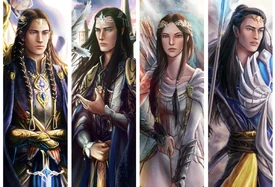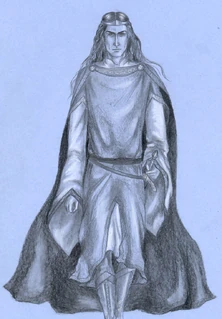Fingon the "Valiant" was a Ñoldorin Elf, the eldest son of Fingolfin, and older brother of Turgon, Aredhel, and Argon.[2]
He was High King of the Ñoldor in Middle-earth during the First Age after the death of his father. He was instrumental in healing the rift between the Sons of Fëanor and the followers of his father after their desertion of them in Araman.
Biography
Fingon was born in Aman, probably in Tirion where the House of Finwë was located. When the Ñoldor were resolved to return to Middle-earth, Fingon followed his father and his people, though they were drawn more to the ruling of their own realms and adventurism rather than vengeance and the recovery of the Silmarils, as Fëanor and his sons sought. He fought in the first Kinslaying but only because he, seeing Elf fighting Elf, believed that the Teleri had been told to prevent the Ñoldor from leaving Aman by force by the Valar.[3]
After Fëanor's abandonment of them, Fingon and his people were led by Fingolfin across the perilous Helcaraxë. They arrived in Middle-earth at the beginning of the First Age, and the Ñoldor witnessed the rising of the Sun.

After the Dagor-nuin-Giliath and the death of Fëanor, Maedhros, Fingon's cousin and friend, was taken and hung by the wrist upon Thangorodrim. Fingon went to Thangorodrim and with the help of Thorondor, Lord of the Eagles, found Maedhros. Maedhros begged Fingon to kill him, but Fingon instead severed Maedhros's hand by the wrist, and brought him back to the Ñoldorin camp. It was this act of bravery and compassion that resolved the dispute as to whose house would rule over the Ñoldor in Middle-earth, for Maedhros renounced his claim to the High Kingship of the Ñoldor, instead ceding it to the House of Fingolfin.[4]
Fingolfin gave Fingon a domain in Dor-lómin, in the west of Hithlum, where he did good service during the Siege of Angband, defeating an Orc army that attempted to go around to the north and attack Hithlum from the west, and then later the first to fight against the dragon Glaurung when he first came forth from Angband during the Dagor Aglareb.[5]
Fingon became High King when Fingolfin died dueling with Morgoth after the Dagor Bragollach. Seven years later, Morgoth's forces invaded Hithlum, and Fingon was hard-pressed and outnumbered, but Círdan and the people of the Falas, who came up the Firth of Drengist rescued them in their ships.[note 1][6]
Fingon's final battle was the Nírnaeth Arnoediad. Fingon led the attack on Angband, and the fury of his warriors nearly won the day. Unfortunately, due to Ulfang's treachery, Maedhros did not arrive until three days after he was expected. This resulted in Morgoth releasing his Balrogs and Glaurung the dragon on the already weakened Ñoldor force. When Maedhros finally arrived, hope was reborn for Fingon's army; however, Ulfang's treachery again took effect, causing Maedhros to withdraw. Fingon was then surrounded and his guards killed. He dueled Gothmog, the first and greatest Lord of Balrogs, and managed to hold his own for a while. However Lungorthin, the second and lesser Balrog Lord emerged into elven history. This Balrog restrained Fingon from behind with a flaming whip, allowing Gothmog to split Fingon's head with his infamous black axe. Thus the day ended in defeat for the Elves.[7]
His younger brother Turgon became the next rightful High King of the Ñoldor, even though his host retreated after the battle and remained secretly in Gondolin.[8]

Descendants
In the published The Silmarillion, Fingon was the father of Gil-galad,[6] but Christopher Tolkien later said that this was due to an an error he made in editing the The Silmarillion, and that his father's intention was that Gil-galad was the son of Orodreth of the House of Finarfin. In fact, because Fingon did not have any sons, the title of High King of the Ñoldor passed to his brother Turgon and then to his nephew Gil-galad.
It is disputed whether Tolkien's son says about Fingon's intention is true, and that therefore Gil-galad was the son of Orodreth, or whether the information in The Silmarillion is more authoritative. Logically, The Silmarillion accords with canon, as the high kingship belonged to the House of Fingolfin, not the House of Finarfin, which entitled Gil-galad to the Kingship.
Character
Fingon was described as follows: "His valour was as a fire yet steadfast as the hills of stone; wise he was and skilled in voice and hand; troth and justice he loved and bore goodwill to all, both Elves and Men, hating Morgoth only; he sought not his own, neither power nor glory, and death was his reward."[9][10]
Etymology
Fingon is the Sindarin version of his Quenya father-name Findekáno.[10] The exact origin of Findekáno is not specified, but it may derive from the words findë ("hair") or phin ("skill"), and kane ("valour")[11] or káno ("commander, lesser chief").[10]
The name Findekáno means " hair commander". In Sindarin, fin translates to "hair".[12]
House of Fingolfin


|
|
| Finwë |
| Indis | ||||||||||||||||||||||||||||||||||||||||||||||||||||||||||||||||||||||||||||||||||||||||||||||||||||||||||||||
|
|
|
|
|
|
|
|
|
|
|
|
|
|
|
|
|
|
| |||||||||||||||||||||||||||||||||||||||||||||||||||||||||||||||||||||||||||||||||||||||||||||||||
| Findis |
| Fingolfin |
| Anairë |
| Irimë |
| Finarfin | ||||||||||||||||||||||||||||||||||||||||||||||||||||||||||||||||||||||||||||||||||||||||||||||||||||||||||
|
|
|
|
|
|
|
|
|
|
|
|
|
|
|
|
|
|
|
|
|
|
|
| ||||||||||||||||||||||||||||||||||||||||||||||||||||||||||||||||||||||||||||||||||||||||||||
| Fingon |
| Turgon |
| Elenwë |
| Aredhel |
| Eöl |
| Argon | ||||||||||||||||||||||||||||||||||||||||||||||||||||||||||||||||||||||||||||||||||||||||||||||||||||||||
|
|
|
|
|
|
|
|
|
|
|
|
|
|
|
|
| |||||||||||||||||||||||||||||||||||||||||||||||||||||||||||||||||||||||||||||||||||||||||||||||||||
|
|
|
|
|
|
| Idril |
| Tuor |
| Maeglin | ||||||||||||||||||||||||||||||||||||||||||||||||||||||||||||||||||||||||||||||||||||||||||||||||||||||||
|
|
|
|
|
|
|
|
|
|
| |||||||||||||||||||||||||||||||||||||||||||||||||||||||||||||||||||||||||||||||||||||||||||||||||||||||||
|
|
|
|
|
|
|
|
| Eärendil |
| Elwing | ||||||||||||||||||||||||||||||||||||||||||||||||||||||||||||||||||||||||||||||||||||||||||||||||||||||||
|
|
|
|
|
|
|
|
|
|
|
|
|
|
| |||||||||||||||||||||||||||||||||||||||||||||||||||||||||||||||||||||||||||||||||||||||||||||||||||||
|
|
|
|
|
|
|
|
| Elrond |
| Elros | ||||||||||||||||||||||||||||||||||||||||||||||||||||||||||||||||||||||||||||||||||||||||||||||||||||||||
Other versions of the legendarium
In earlier versions of the legendarium, Fingon had a sons called Findobar.[9][13] In another account he had a son, Finbor, and a daughter, Erien.[10]
Translations
| Foreign Language | Translated name |
| Amharic | ፌንጎን |
| Arabic | فينغون (Fingon)
فينغون الشجاع (Fingon, the Valiant) |
| Armenian | Ֆինգոն |
| Assamese | ফিংগন |
| Belarusian Cyrillic | Фингон |
| Bengali | ফিঙ্গন |
| Bulgarian Cyrillic | Фингон |
| Chinese (Hong Kong) | 芬鞏 |
| Esperanto | Fingono |
| Georgian | ფინგონი |
| Greek | Φινγον |
| Gujarati | ફિન્ગોન |
| Hebrew | פינגון |
| Hindi | फ़िङोन |
| Japanese | フィンゴン |
| Kannada | ಫಿಂಗನ್ |
| Kazakh | Фингон (Cyrillic) Fïngon (Latin) |
| Korean | 핑곤 |
| Kyrgyz Cyrillic | Фингон |
| Macedonian Cyrillic | Фингон |
| Maithili | फिंगन |
| Malayalam | ഫിംഗൺ |
| Marathi | फिंगोन |
| Mongolian Cyrillic | Фангон |
| Nepalese | फिंगन |
| Pashto | فنگون |
| Persian | فینگون |
| Punjabi | ਫਿੰਗੋਨ |
| Russian | Фингон |
| Serbian | Фингон (Cyrillic) Fingon (Latin) |
| Sinhalese | ෆින්ග්න් |
| Tajik Cyrillic | Фингон |
| Tamil | பைங்கொண் |
| Telugu | ఫింగ్న్ |
| Thai | Fิงโน |
| Ukrainian Cyrillic | Фінгон |
| Urdu | فنگاون |
| Uzbek | Фингон (Cyrillic) Fingon (Latin) |
| Yiddish | פינגאָן |
| High King of the Ñoldor | ||
| Preceded by Fingolfin |
Fingon | Succeeded by Turgon |
| FA 455 - FA 473 | ||
Notes
- ↑ At this point in The Silmarillion, Fingon was said to have sent his wife and son Ereinion (Gil-galad) to the havens for safety, but this was an editorial mistake by Christopher Tolkien, and Fingon is said "to have no wife or children".
References
- ↑ The Nature of Middle-earth, I: "Time and Ageing: Ageing of Elves", XXII: "A Fragment from The Annals of Aman" (p. 164)
- ↑ The Silmarillion, Quenta Silmarillion, Chapter V: "Of Eldamar and the Princes of the Eldalië"
- ↑ The Silmarillion, Quenta Silmarillion, Chapter IX: "Of the Flight of the Ñoldor"
- ↑ The Silmarillion, Quenta Silmarillion, Chapter XIII: "Of the Return of the Ñoldor"
- ↑ The Silmarillion, Quenta Silmarillion, Chapter XIV: "Of Beleriand and its Realms"
- ↑ 6.0 6.1 The Silmarillion, Quenta Silmarillion, Chapter XVIII: "Of the Ruin of Beleriand and the Fall of Fingolfin"
- ↑ The Silmarillion, Quenta Silmarillion, Chapter XX: "Of the Fifth Battle: Nirnaeth Arnoediad"
- ↑ The Atlas of Middle-earth
- ↑ 9.0 9.1 The History of Middle-earth, Vol. V: The Lost Road and Other Writings, Part Three: "The Etymologies", Appendix I: "The Genealogies"
- ↑ 10.0 10.1 10.2 10.3 The History of Middle-earth, Vol. XII: The Peoples of Middle-earth, chapter XI: "The Shibboleth of Fëanor"
- ↑ The History of Middle-earth, Vol. V: The Lost Road and Other Writings, Part Three: "The Etymologies"
- ↑ The Silmarillion, Appendix: Elements in Quenya and Sindarin names
- ↑ The History of Middle-earth, Vol. IV: The Shaping of Middle-earth, chapter III: "The Quenta"